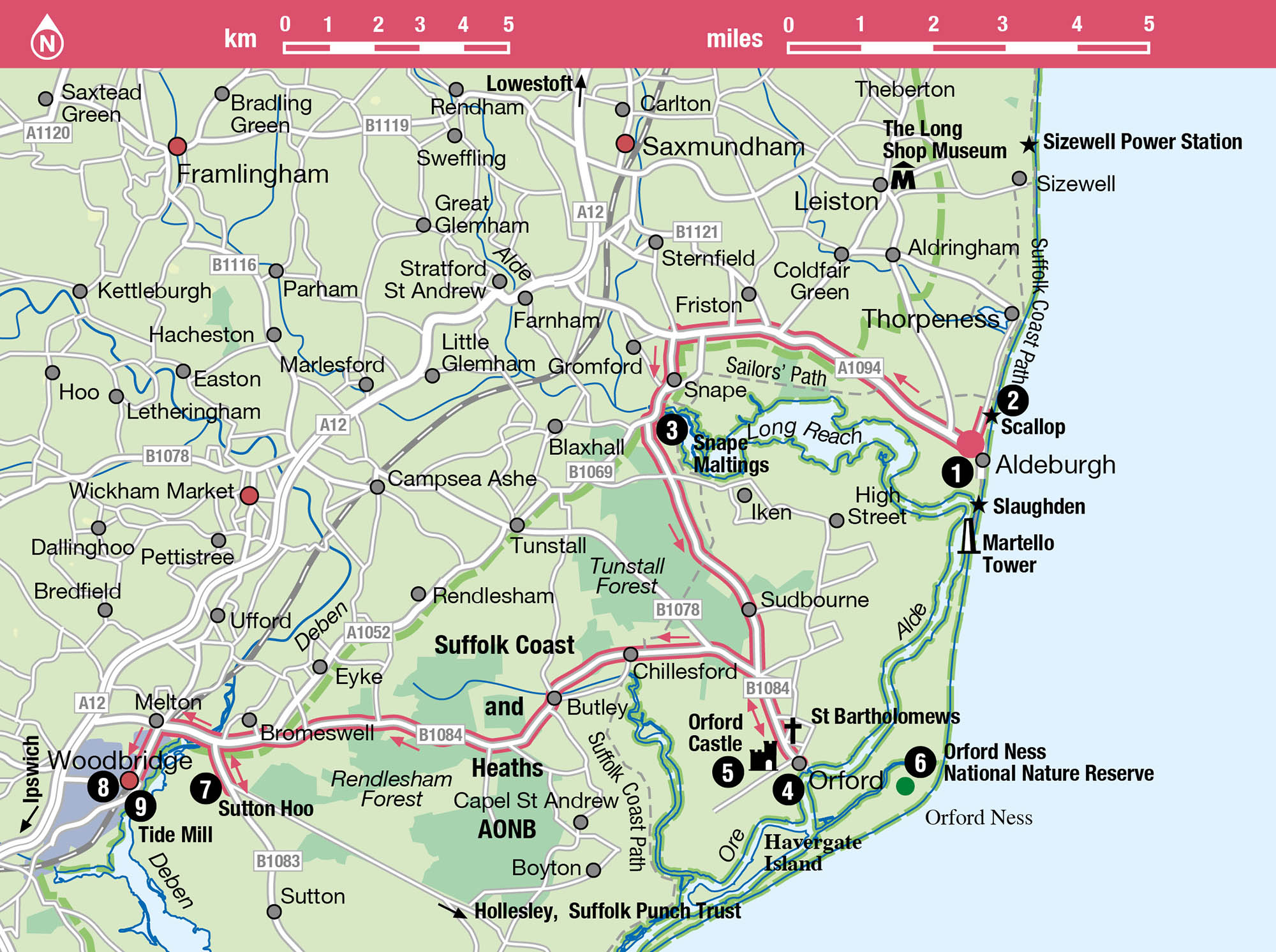Aldeburgh is a prosperous little town and seaside resort, with the charm of a bygone era. The town acquired international fame through the music festival, held here until 1967 when new premises were acquired at Snape. But Aldeburgh is still very much a festival centre, hosting concerts and exhibitions and accommodating Snape audiences. The composer Benjamin Britten (1913–76) spent most of his adult life in or near Aldeburgh and it was here that he wrote some of the best-known classical music of the 20th century and founded the Aldeburgh Festival (for more information, click here) with Peter Pears. With its shingle beach, boats and fish huts, Aldeburgh is a delightful spot to stay and has an exceptionally good choice of accommodation and restaurants. If you have more than a day, this route could be linked to Tour 7 (for more information, click here), covering the coast to the north.
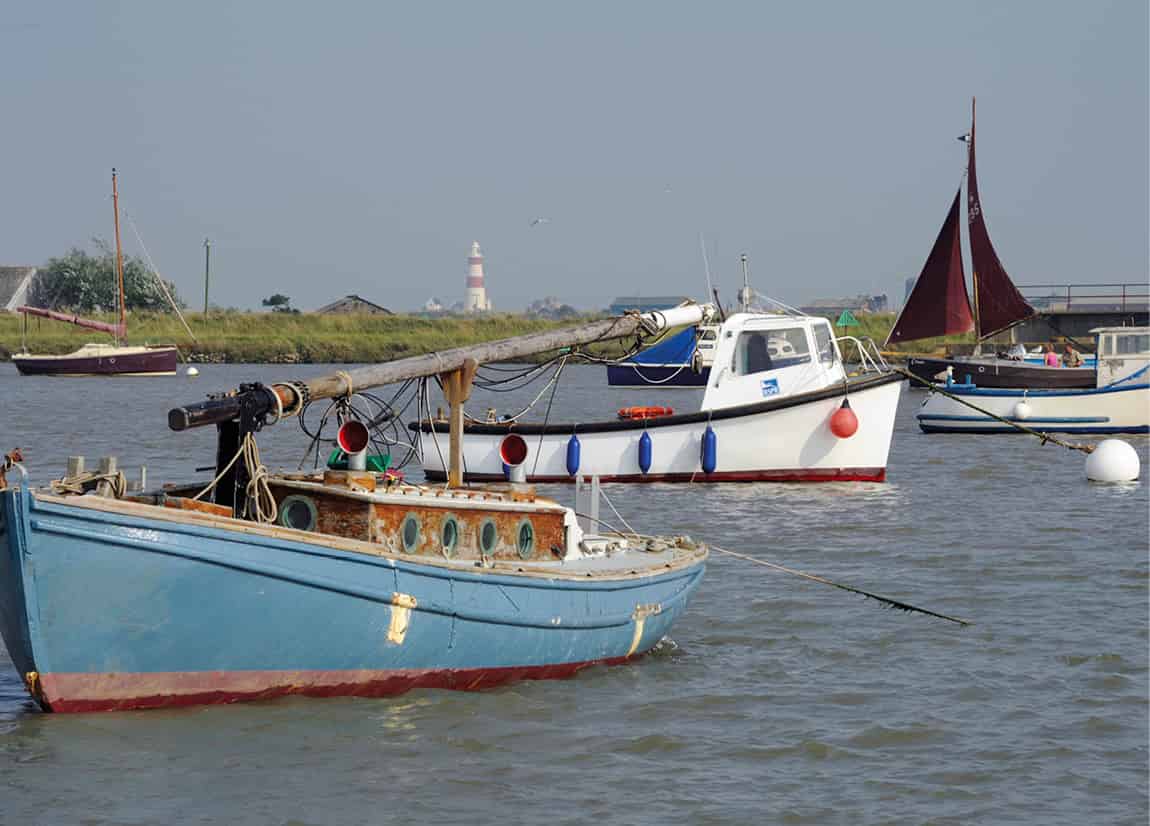
Boats moored at Orford Quay.
Sylvaine Poitau/Apa Publications
Aldeburgh
Parking in the centre of Aldeburgh 1 [map] can be tricky, but there are car parks on Thorpe Road to the north (charge) and Slaughden Quay to the south (free). Start on the waterfront at the lovely, brick and timber-framed Moot Hall, a fine Tudor building that formerly stood well inland from the sea. A symbol of Aldeburgh, It has been a venue for council meetings for over 400 years and houses a small museum (daily Apr–Oct 2.30–5pm, June–Aug from noon). Along the seafront fishermen land their glistening catch and fresh fish are sold from the huts on the steeply shelving shingle beach.
Just south of the Moot Hall, Crag House at 4 Crabbe Street was Benjamin Britten’s seafront home from 1947–57. On the same street, Jubilee Hall is a venue for concerts, the poetry festival and summer theatre.
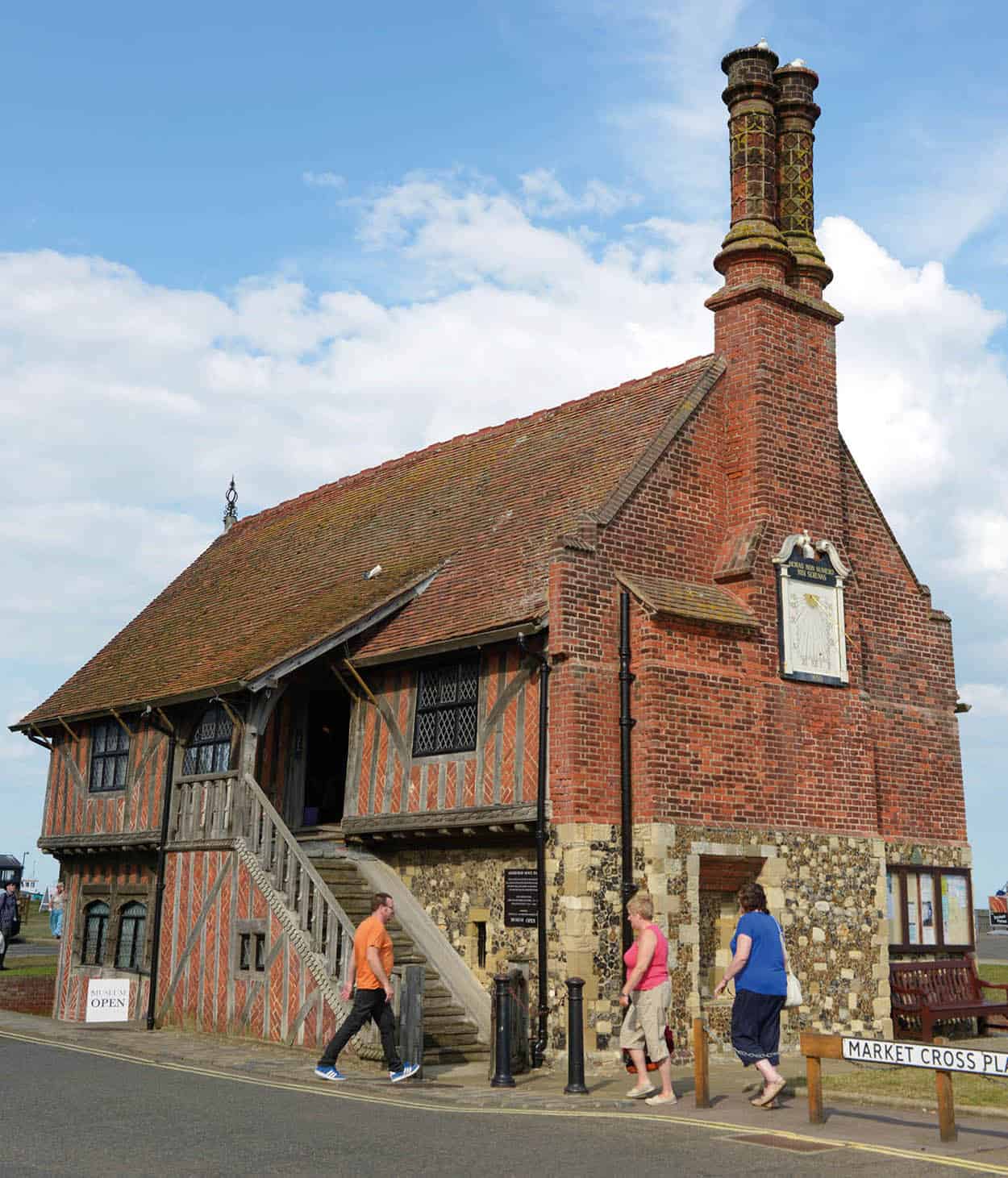
The Tudor Moot Hall in Aldeburgh.
Sylvaine Poitau/Apa Publications
Along Crag Path, with desirable residences right on the seafront, you’ll find the Aldeburgh Beach Lookout tower, a quirky 19th-century folly, which was sold with the proviso it must be used for artistic purposes. Sir Laurens van der Post used to write here in his later years, in the tiny room half way up. The tower was bought by Caroline Wisemen, an international art dealer who was inspired by Aldeburgh and who has turned the tower into a place where established and emerging artists can also come and be inspired by the Aldeburgh coastline. Exhibitions are held here (and in the house across the road) and Caroline offers week-long residences at the Lookout – at the end of the week their creations are revealed to the public at the tower. The Aldeburgh Academy, run by David Baldry, offers three-day art courses during the summer months.
Running parallel with the sea, the High Street retains many independent shops, with appealing galleries, boutiques, delis and a wonderful book shop. Carry on walking south and you come to the clover-shaped Martello Tower, built, like many along the East coast, in preparation for Napoleonic attacks – which never happened. It’s a great place to watch the sea and can be rented as self-catering accommodation through the Landmark Trust (www.landmarktrust.org.uk).
Maggi Hambling’s Scallop
A short walk north along the beach from the Moot Hall brings you to Maggi Hambling’s huge steel Scallop 2 [map] , dedicated to Benjamin Britten. On a heritage coast where little has changed over the years, the sculpture was a hotly controversial topic when unveiled in 2003. It has been subject to graffiti and vandalism, though the attacks have abated in recent years. Locals are still divided over its aesthetic merit but it has become something of a magnet for visitors, especially for snap-happy tourists and children who like to hide behind the interlocking shells – rather than contemplating the mysterious power of the sea, which Maggi Hambling intended. If nothing else Scallop is a great talking point and provides excellent photo opportunities – it looks different from every angle and changes colour as you look at it. The words that are pierced through the steel and read against the sky – ‘I hear those voices that will not be drowned’ – come from Britten’s opera Peter Grimes.
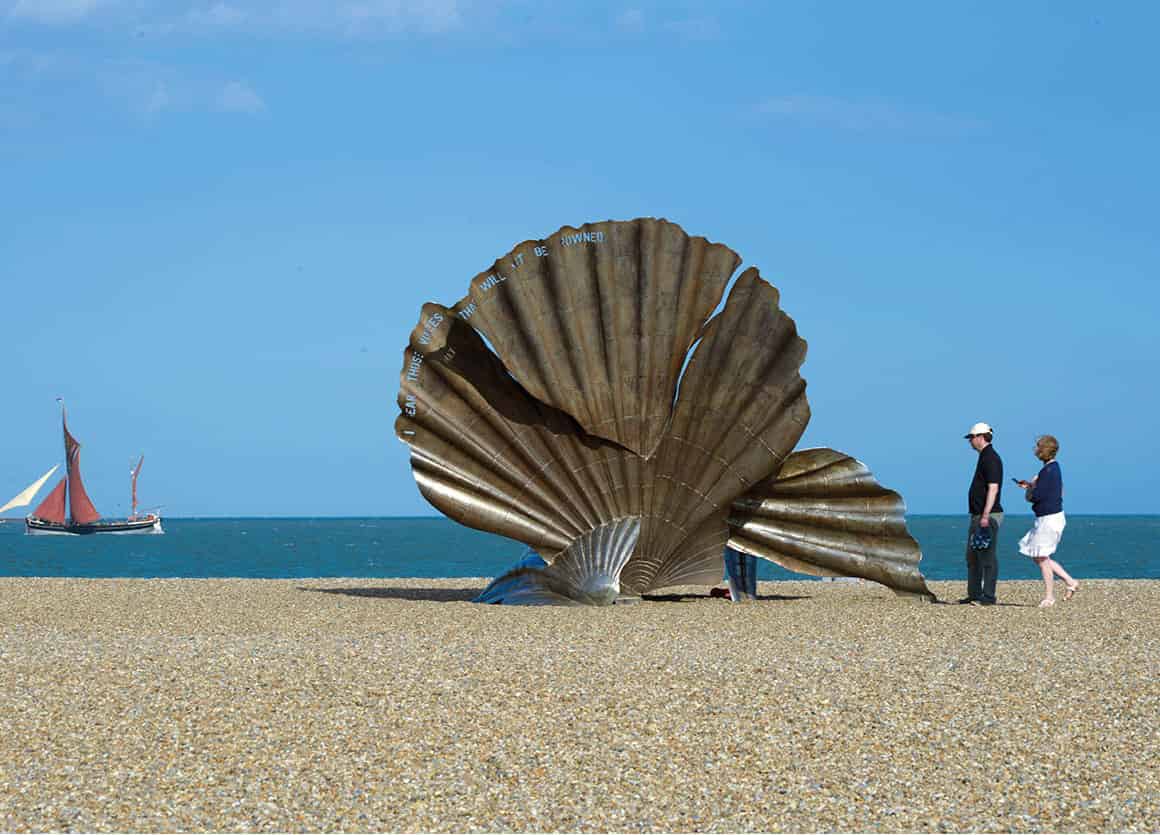
Maggi Hambling’s Scallop on Aldeburgh beach.
Sylvaine Poitau/Apa Publications
Thorpeness
A 30-minute walk or a couple of minutes’ car journey along the narrow coastal road north of Aldeburgh will bring you to Thorpeness. This was just a fishing hamlet until it was transformed in the 1920s into a fantasy holiday haven, with a boating lake and Peter Pan-themed islands, a fairytale cottage on stilts, a country club and mock Tudor and Jacobean homes. It even had its own railway station. The entrepreneur behind the scheme was Glencairn Stuart Ogilvie, a Scottish lawyer and playwright. It was hailed as the new Suffolk seaside resort and is still very much a holiday attraction with its 64-acre (25-hectare) boating lake, golf course and the House in the Clouds, perched on top of a water tower, and available for self-caterers who like a view.
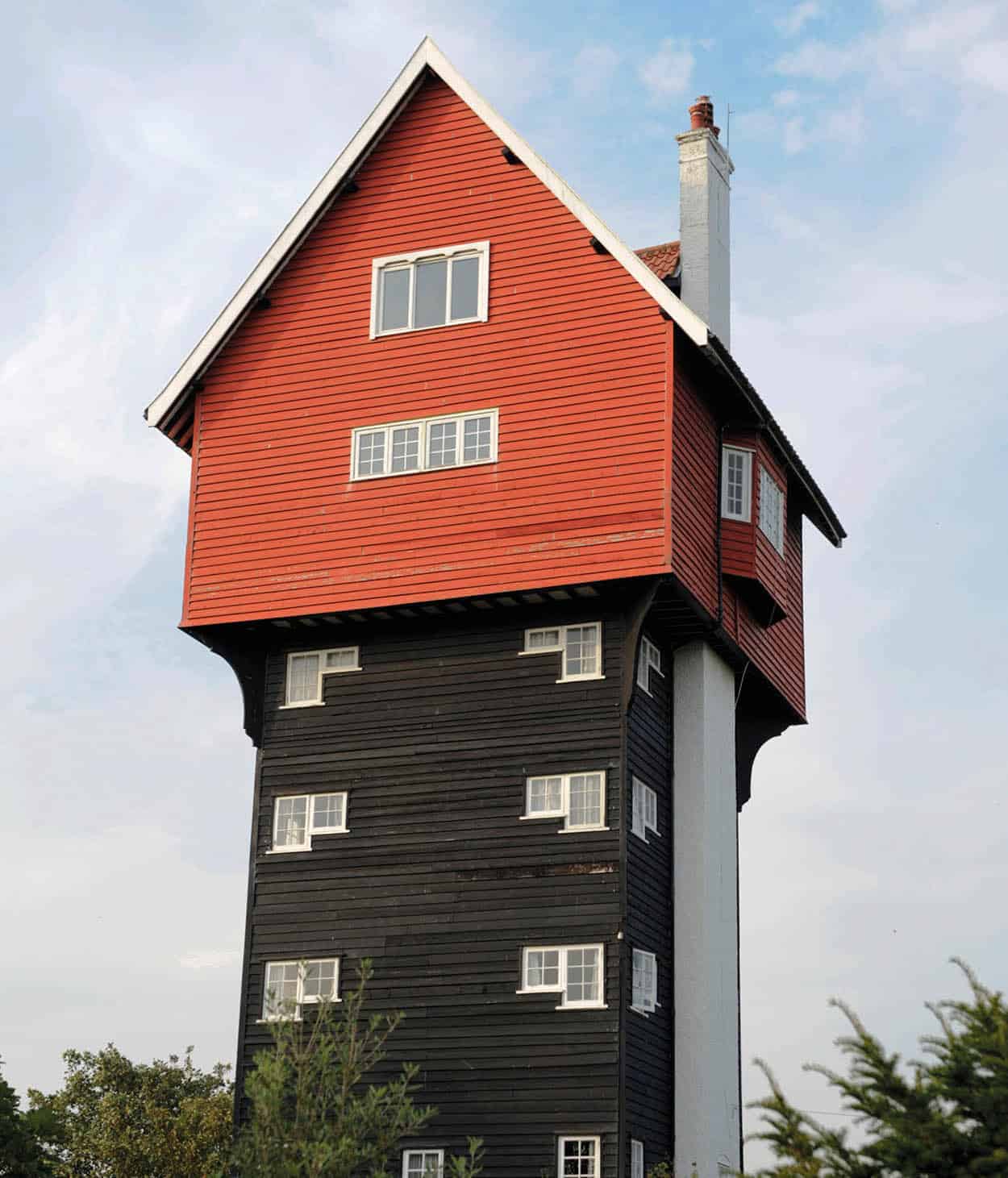
A room with a view – the House in the Clouds, Thorpeness.
Sylvaine Poitau/Apa Publications
Snape Maltings
From Aldeburgh take the A1094 heading inland, turning left for Snape after about 4 miles (6km). Formerly one of the largest barley maltings in East Anglia, Snape ceased operation in the 1960s. The 19th-century complex of red-brick granaries and malt houses beside the Alde estuary were converted by Benjamin Britten into a concert hall and the Aldeburgh Festival has been held here ever since. For information and booking for the year-round concert hall programme visit www.snapemaltings.co.uk.
Long Shop Museum
Northwest of Aldeburgh, Leiston’s Long Shop Museum (http://www.longshopmuseum.co.uk/; Mon–Sat 10am–5pm, Sun 11am–3pm) is the site of the Leiston Works, which turned the town into a prosperous manufacturing centre in the 19th century. The works were owned by Richard Garrett & Sons, who made steam tractors, cast-metal products and munitions for both World Wars. The museum charts 200 years of machinery and includes displays on the nuclear power stations at nearby Sizewell.
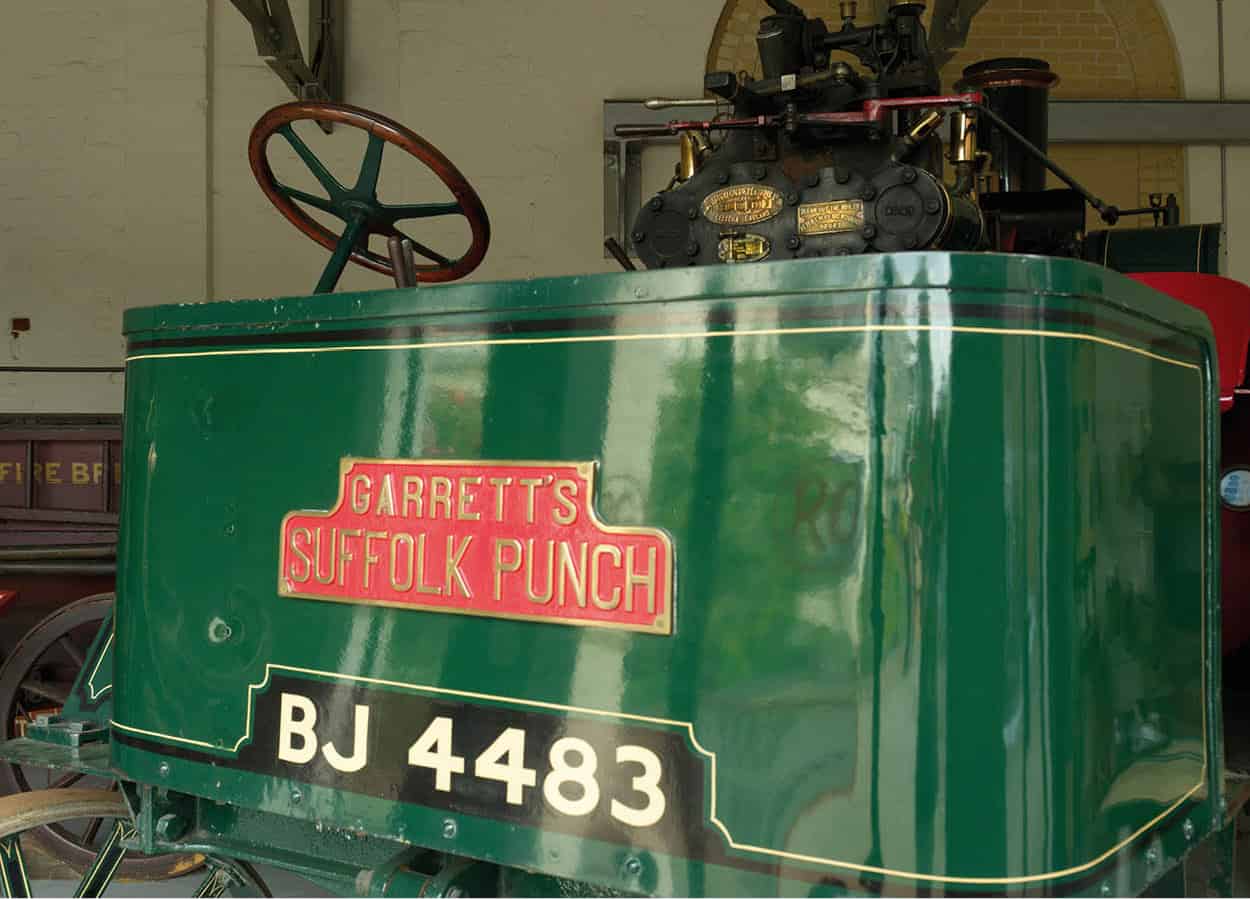
Vintage machinery on display at the Long Shop Museum.
Sylvaine Poitau/Apa Publications
Snape Maltings 3 [map] (tel: 01728-688 303; www.snapemaltings.co.uk; daily 10am–5.30pm) today is a 7-acre (3-hectare) site overlooking wildlife-rich reed beds. It’s a beautiful setting, with grounds enhanced by modern sculpture, including striking works by Henry Moore and Barbara Hepworth. Snape now has a nature reserve with walks along the River Alde and boat trips in season. The shops in the converted granaries are alone worth a visit. On the food scene it has an artisan bakery, a gourmet deli, an excellent café, the Granary tearooms, a pub and a wonderful farmers’ market held every first Saturday of the month (9.30am–1pm). It is also the venue of the annual Aldeburgh Food and Drink Festival, held in the autumn. Other shops include classy boutiques, children’s toys and clothes, fine furnishings, kitchenware, pottery, crafts and cards.
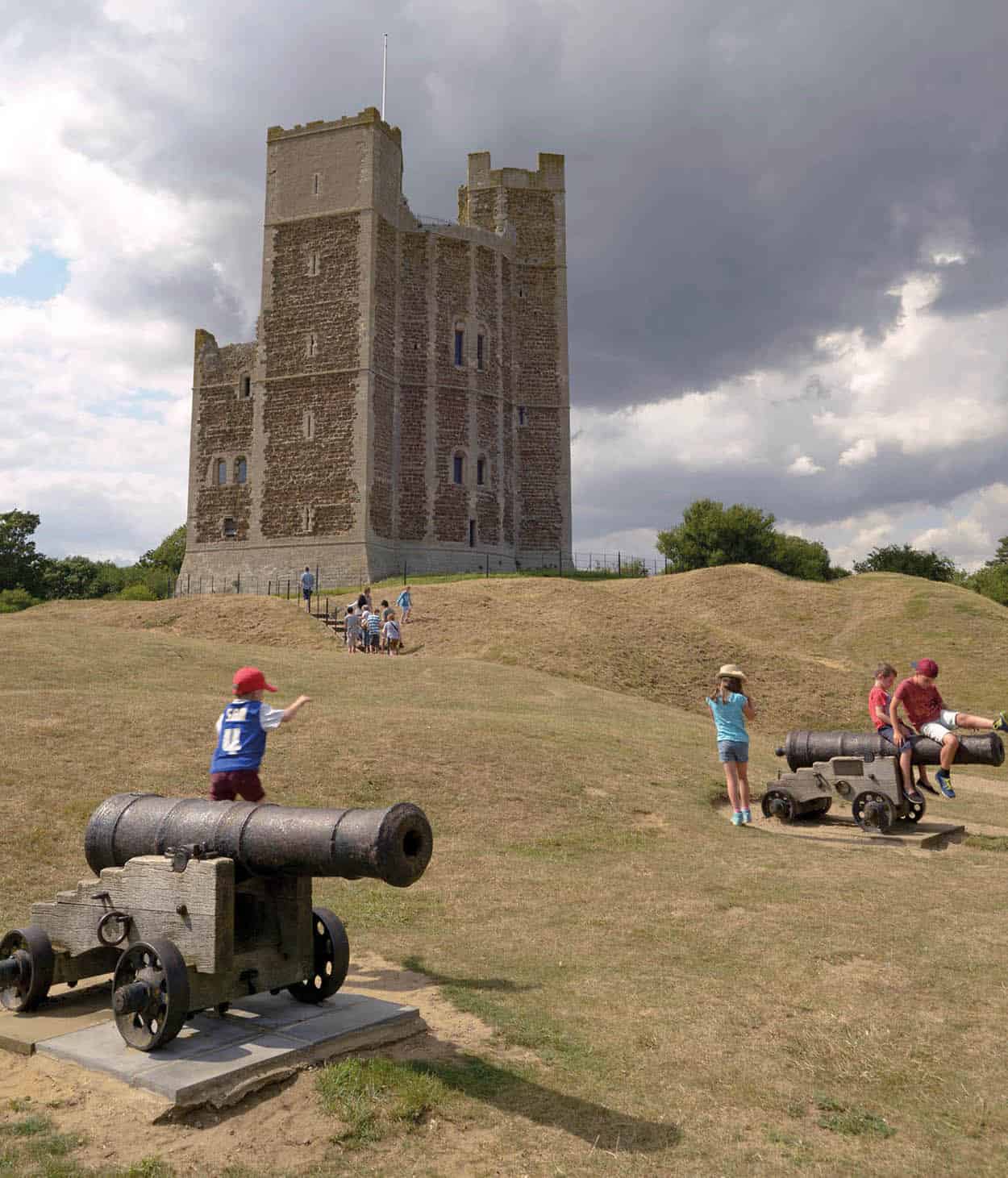
Orford Castle.
Sylvaine Poitau/Apa Publications
Orford
From Snape Maltings take the Snape Road south via Sudbourne to Orford (5.5 miles/9km). Once a thriving port and town, Orford 4 [map] is a mere village dominated by the mighty keep of the former Orford Castle 5 [map] (tel: 01394-450 472; www.english-heritage.org.uk; Apr–Sept daily 10am–6pm, Oct daily 10am–5pm, Nov–Mar Sat–Sun 10am–4pm). The military stronghold was built by Henry II as part of a series of coastal defences in 1165. The gradual formation by the North Sea of the shingle spit (Orford Ness) led to the demise of the port and the decline of what were originally extensive castle fortifications. The castle became home to coastal defences during World War II in its life as a radar station. The 90ft (27-metre) -high keep, the oldest five-sided keep in the country, soars above the village, and the top of the tower (91 steps) commands great views across to Orford Ness.
The nearby Church of St Bartholomew, vast in proportion to today’s village, was the setting of some of the early performances by Benjamin Britten, and concerts are held here during the Aldeburgh Festival. Orford may be tiny but it is something of a foodie haven, famous for seafood and home to an oysterage, a smokehouse, a scratch bakery and Suffolk butcher, two pubs and riverside tearooms with home-made cakes. A further lure is the Crown and Castle, now a bed and breakfast with 21 rooms, whose Trinity Restaurant serves up decent, unpretentious food. Pinney’s of Orford, dating from the 1950s, has a shop near the quay. Their oyster beds and smokehouse are down on Butley Creek and their products are used at their excellent restaurant, The Butley Orford Oysterage, which opened in 1961 (for more information, click here).
Dining on the Alde
Spot the avocets and learn about local wildlife on the Lady Florence (tel: 07831-698 298; www.lady-florence.co.uk), a 1940s Admiralty MFV supply boat. Trips start at Orford, cruise the length of the Orford Ness conservation area and circumnavigate the RSPB’s Havergate Island bird sanctuary. The maximum number of passengers is 12, there’s a comfy salon, a coal fire in winter and a choice of brunch, lunch, dinner or sunset cocktail cruises, all at reasonable prices.
The road past the old Jolly Sailor Inn leads to Orford Quay with a hut selling fresh fish, a simple café, and, weather permitting, boat trips to Havergate Island to see avocets and other waders. Ferries take passengers from here to Orford Ness National Nature Reserve 6 [map] (www.nationaltrust.org.uk), a desolate 10-mile (16km) shingle spit known for breeding and migratory birds. From 1913 to the mid-1980s the Ness was used as a military test site and secret experiments were carried out here. Derelict concrete buildings used for the testing are the legacy of this secret era.
Ipswich
From Woodbridge it’s only 9 miles (15km) to Ipswich, the county town of Suffolk. It is a large town with unappealing outskirts, but it now has a regenerated waterfront where you can sit at cafés and watch the yachts, or take a cruise along the River Orwell. Christchurch Mansion in the eponymous park is a handsome Tudor building with a good collection of paintings by Constable and Gainsborough.
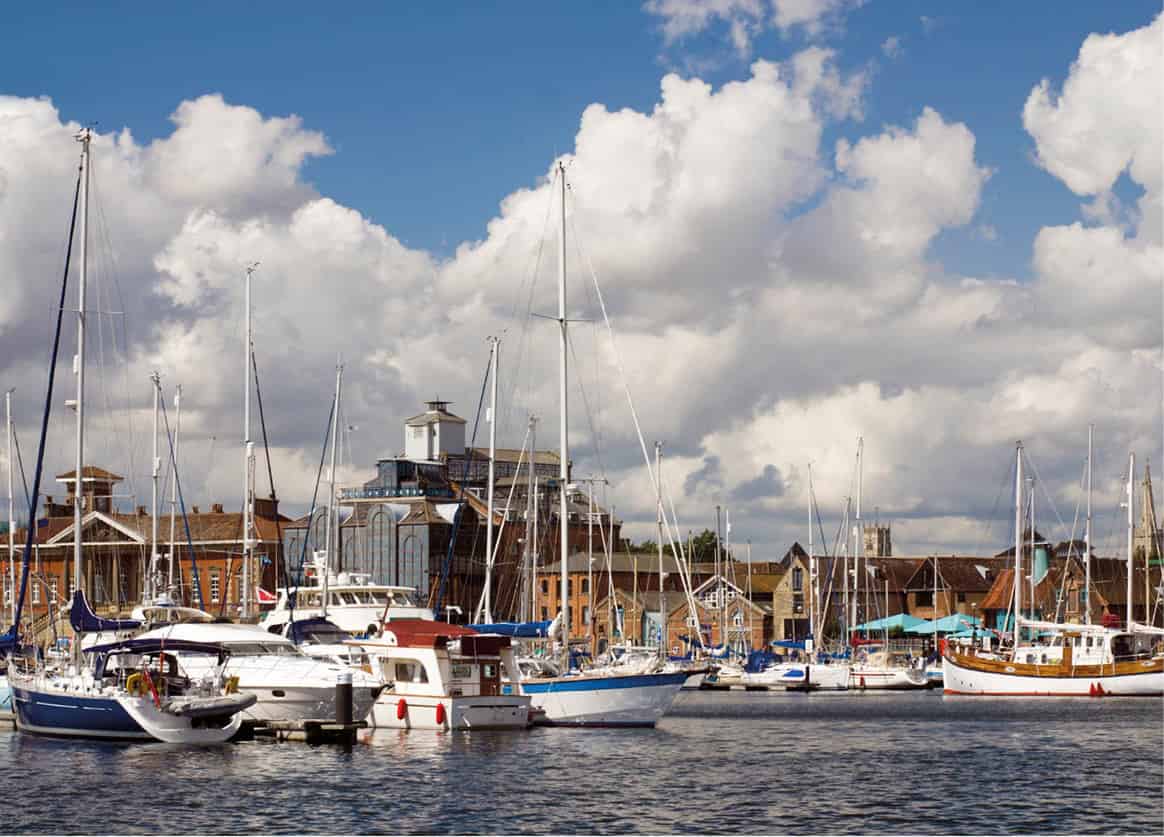
Ipswich’s regenerated waterfront and harbour.
iStock
From Orford take the B1084 west towards Woodbridge. After 9 miles (15km) turn left on to the B1083 for Sutton Hoo 7 [map] (tel: 01394-389 700; www.nationaltrust.org.uk; Apr–Oct daily 10.30am–5pm, Nov–Mar Sat–Sun 11am–4pm), one of the country’s most significant Anglo-Saxon sites. In 1939, just before World War II, the landowner, Mrs Edith Pretty, asked amateur archaeologist, Basil Brown, to excavate the grassy mounds on her land. The dig revealed the rotting timbers of an 89ft (27-metre) long ship, thought to have been used as the burial chamber of the Saxon King Raedwald of East Anglia in the 7th century. The ship was packed with the most priceless hoard of Anglo-Saxon treasure ever discovered. Sadly you can’t see it here as it was taken to the British Museum for safekeeping.

Anglo-Saxon shield replica at Sutton Hoo.
Sylvaine Poitau/Apa Publications
The site nevertheless has a fascinating exhibition, with replicas of the treasure, including the famous silver and gold ceremonial helmet which is the symbol of Sutton Hoo. The audio-guides feature Basil Brown himself describing the dig. Visitors can see the reconstructed burial chamber, visit some of the rooms in Mrs Pretty’s house, with interesting correspondence about the discovery, and wander around burial mounds. It’s a beautiful site: 245 acres (99 hectares) above the River Deben, with woodland and estuary walks. The one-hour guided tours of the burial mounds are highly recommended but, with or without the tour, allow at least a couple of hours for the whole site.
The Suffolk Punch Trust
At the village of Hollesley, southeast of Woodbridge, the Suffolk Punch Trust (tel: 01394-411 327; www.suffolkpunchtrust.org; check website for opening hours) is an educational and environmental charity dedicated to breeding and preserving the Suffolk Punch horse and its links with East Anglia’s rural heritage. There’s plenty for children, with stallions, mares and foals, along with rare breeds of pigs, sheep and chickens, a play area, garden, country walks and a good café.

A Suffolk Punch in the snow.
iStock
Woodbridge
The unspoilt town of Woodbridge 8 [map] lies just across the River Deben. From Sutton Hoo take the B1083 north, and turn left at the roundabout on to the A1152. In Tudor times the town was a flourishing centre for shipbuilding, sail-making and weaving. Large boats can no longer navigate the River Deben, but this is still a favourite spot among the boating fraternity, with much of the activity focussing on the busy quayside and yacht harbour. It’s also a delightful market town, full of small retailers (its slogan is ‘Choose Woodbridge for real shopping’) and a haven for gourmets with many tempting delis, cafés and restaurants.
The Tide Mill
On the River Deben quayside lies the white clapboard Tide Mill 9 [map] (Tide Mill Way; tel: 01394-385 295; www.woodbridgetidemill.org.uk; Apr–Sept daily 11am–4.30pm, Oct weekends only). The nearest car park is at the railway station just to the west. The mill dates from the 1790s, though the site was first mentioned in 1170. Functioning until 1957 it was the last mill in the country to work by tidal power.

The white clapboard Tide Mill in Woodbridge.
Sylvaine Poitau/Apa Publications
Explore the fully restored and working tide mill, plus exhibits and interactive models presenting an overview of the history and workings of the mill. From here you can follow a riverside walk in either direction, offering the chance to spot oystercatchers, terns, shelduck, avocet and, if you are really lucky, one of the ‘Deben seals’.
Narrow streets lead up from the quay to the town centre, well worth exploring for its Georgian streets, galleries, shops and charming Market Hill. The Dutch gabled Shire Hall (1575) was formerly used on the upper level as a Magistrates’ Court and the ground floor as an open corn market. The little museum across the road has displays on the evolution of Woodbridge from the Anglo-Saxon settlement to the 20th century.
Eating Out
Aldeburgh
Aldeburgh Fish & Chip Shop
226 High Street; tel: 01728-452 250; www.aldeburghfishandchips.co.uk; Mon–Thu noon–2pm and 6–8pm, Sat noon–8pm.
This takeaway chippie’s fame has spread far and wide and some argue it’s the best in the country. The fish and potatoes are local, the batter is light. All in all, it’s well worth the long wait. £
The Lighthouse
77 High Street; tel: 01728-453 377; www.lighthouserestaurant.co.uk; daily noon–2pm and 6.30–10pm.
A favourite haunt of locals. Fish predominates on the menu, with pan-seared scallops, Lighthouse fish soup, oven-baked cod fillets and seabass, but there are always a couple of dishes for keen carnivores. A busy, bustling atmosphere. ££
Regatta Restaurant
171–173 High Street; tel: 01728-452 011; www.regattaaldeburgh.com; Tue–Sat noon–2pm and 6–9pm, also Sun–Mon in summer school holidays.
Cheerful, family-run restaurant with a nautical theme that delivers dishes full of flavour and features recipes from their own smokehouse. There’s an emphasis on fish and seafood but plenty of other options – meat and vegetarian. ££
Thorpeness
The Kitchen@ Thorpeness
Remembrance Road; tel: 01728-453 266; www.thekitchenthorpeness.co.uk; Sun–Thu 9am–5pm, Fri–Sat until 8pm.
Just across the road from the Meare, you’ll find the perfect spot for coffee, home-made cakes, chunky sandwiches and super lunches. Have a wander around the Emporium for collectables and crafts afterwards. £
Snape
Crown Inn
Bridge Road; tel: 01728-688 324; www.snape-crown.co.uk; food: Mon–Fri noon–2.30pm and 6–9.30pm, Sat–Sun noon–3pm and 6–9pm.
You can be assured of locally grown produce at this 15th-century inn. Garry and Teresa Cook rear geese, ducks, Suffolk lamb, rare breed pigs and goats, plus the veg from their allotment at Orford. The local brewery Adnams supplies the ales. Pre- and post-concert meals available. ££
Orford
Market Hill; tel: 01394-450 277; www.pinneysoforford.co.uk; daily noon–2.15pm, also 6.30–9pm seasonally so check in advance.
This long-established seafood restaurant has its own smokehouse and two boats which provide a variety of locally caught fish. Try the plump Butley Creek oysters, home-made smoked salmon paté, creamy fish pie or catch of the day. They also have a shop near the harbour called Pinney’s. ££
Woodbridge
The Table
3 Quay Street; tel: 01394-382 428; www.thetablewoodbridge.co.uk; Mon 10.30am–3pm, Tue–Sat 10.30am–3pm and 6–9pm, Sun noon–3pm.
This brasserie-style restaurant is set in a lovely old building with a courtyard for summer eating. Choose from light fresh bites or mains such as Thai chicken curry or smoked haddock soufflé; veggies are well catered for too. Or stop by for coffee and yummy home-made cakes. ££
